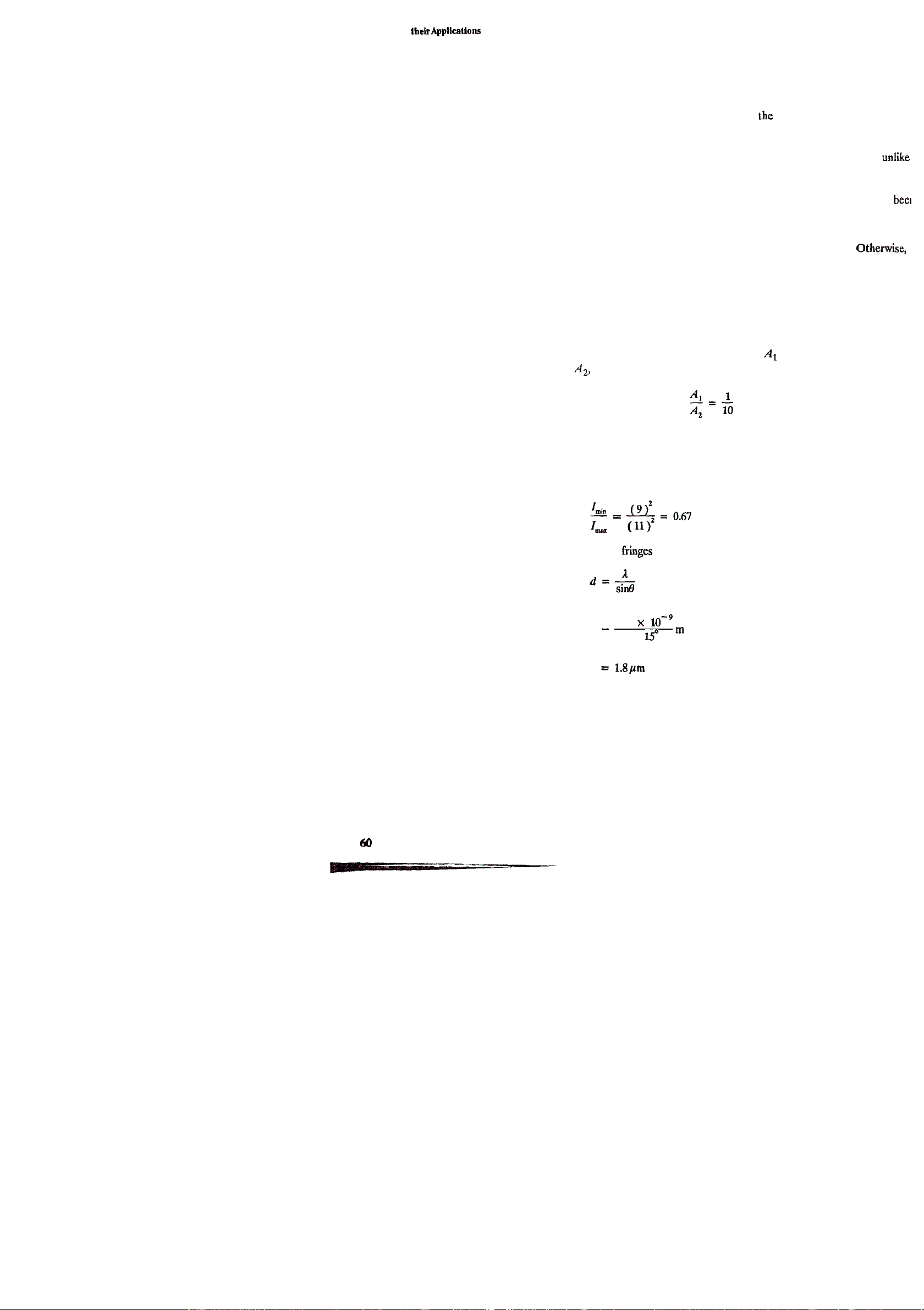
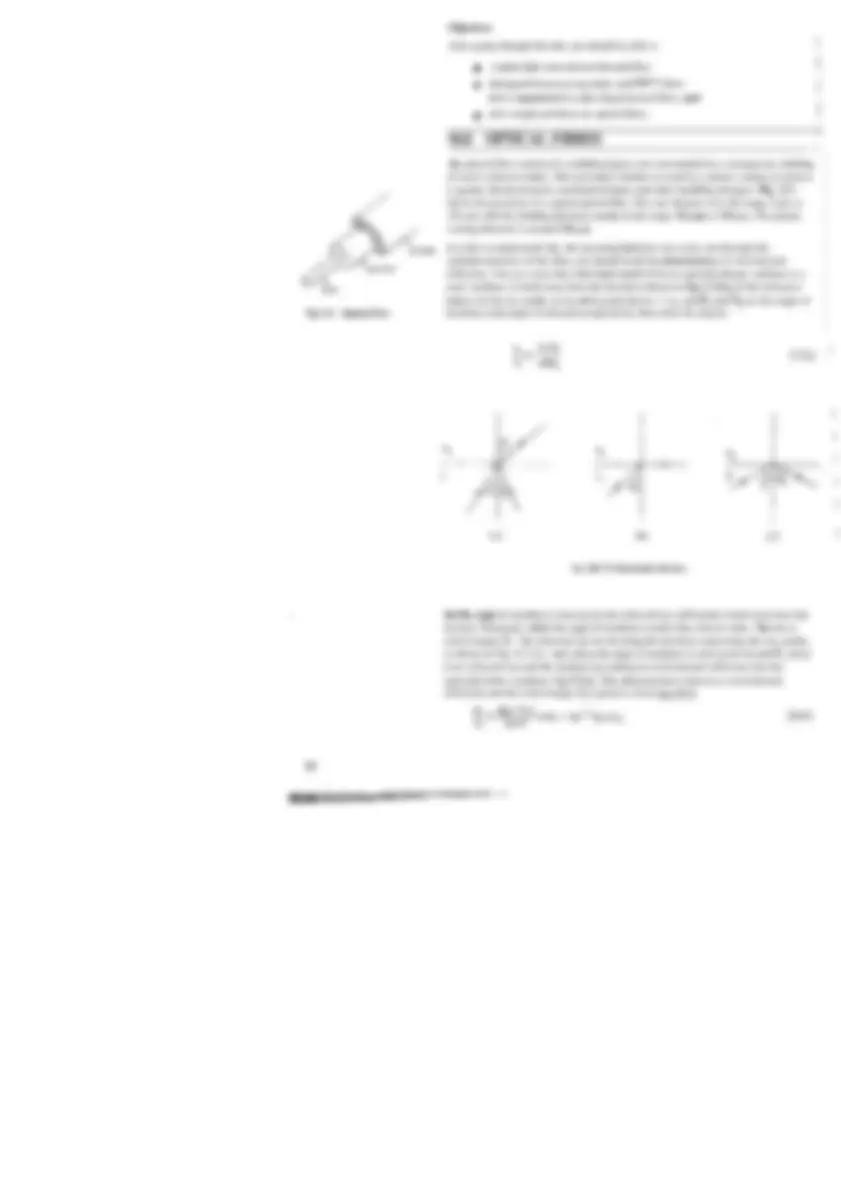
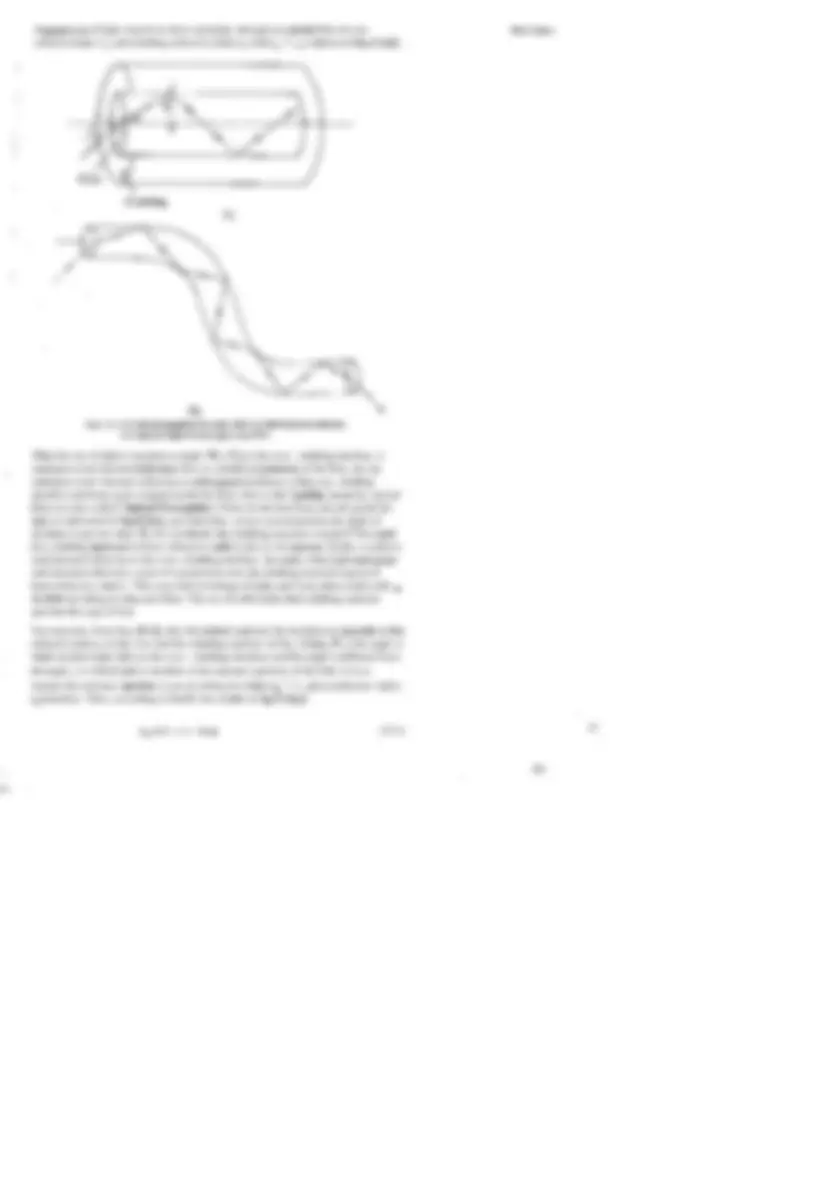
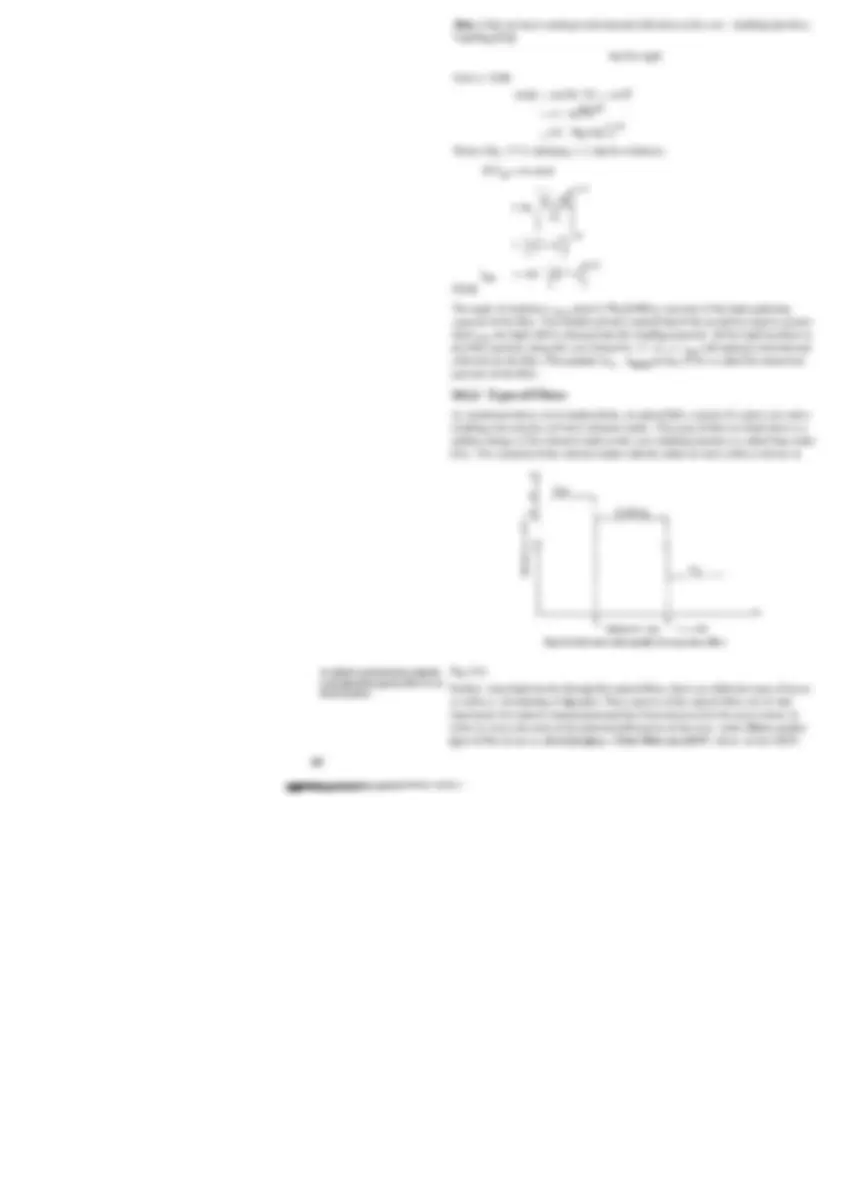
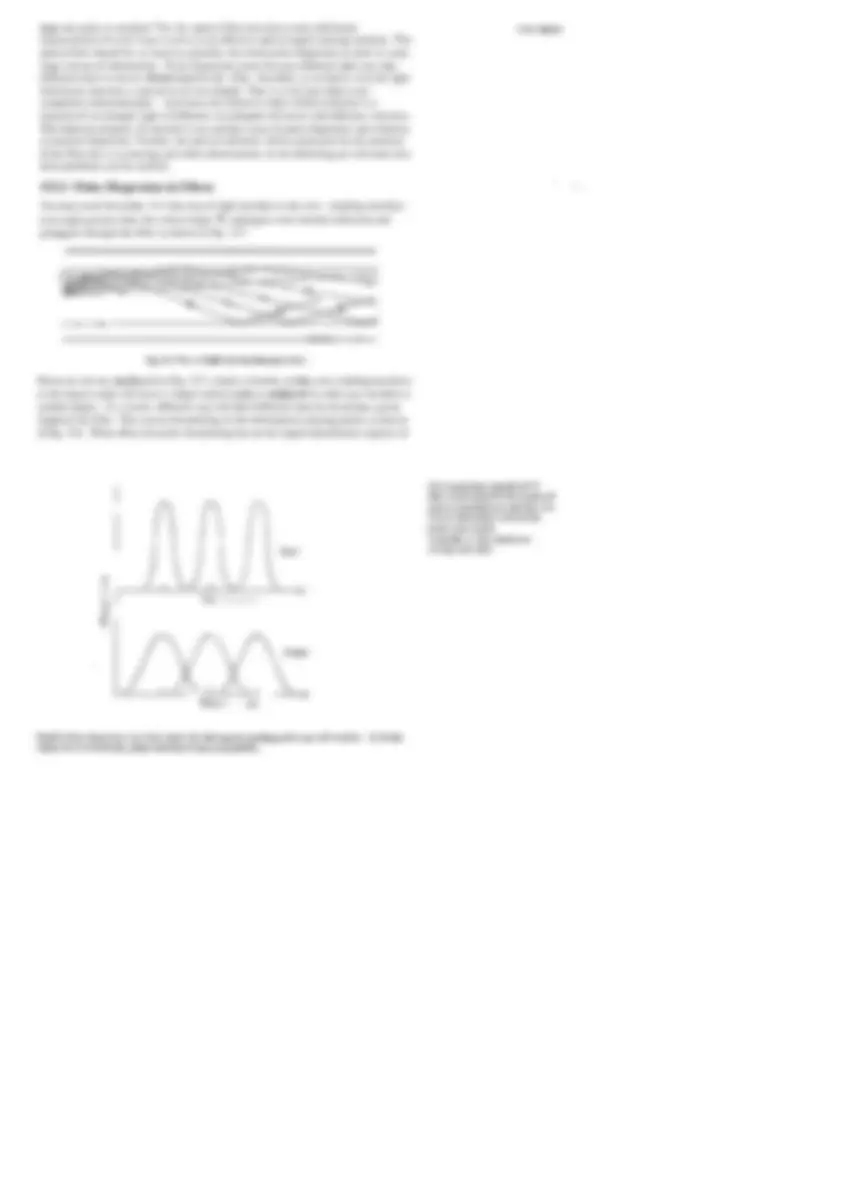
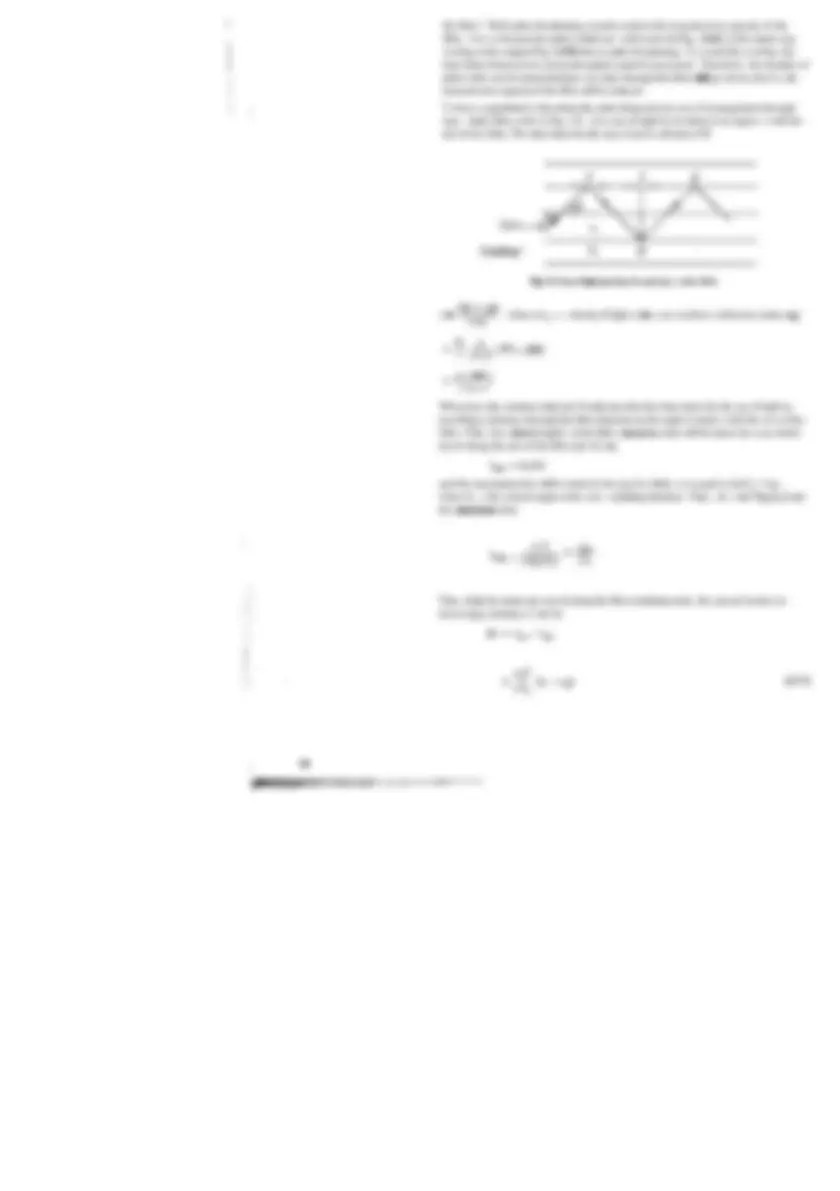
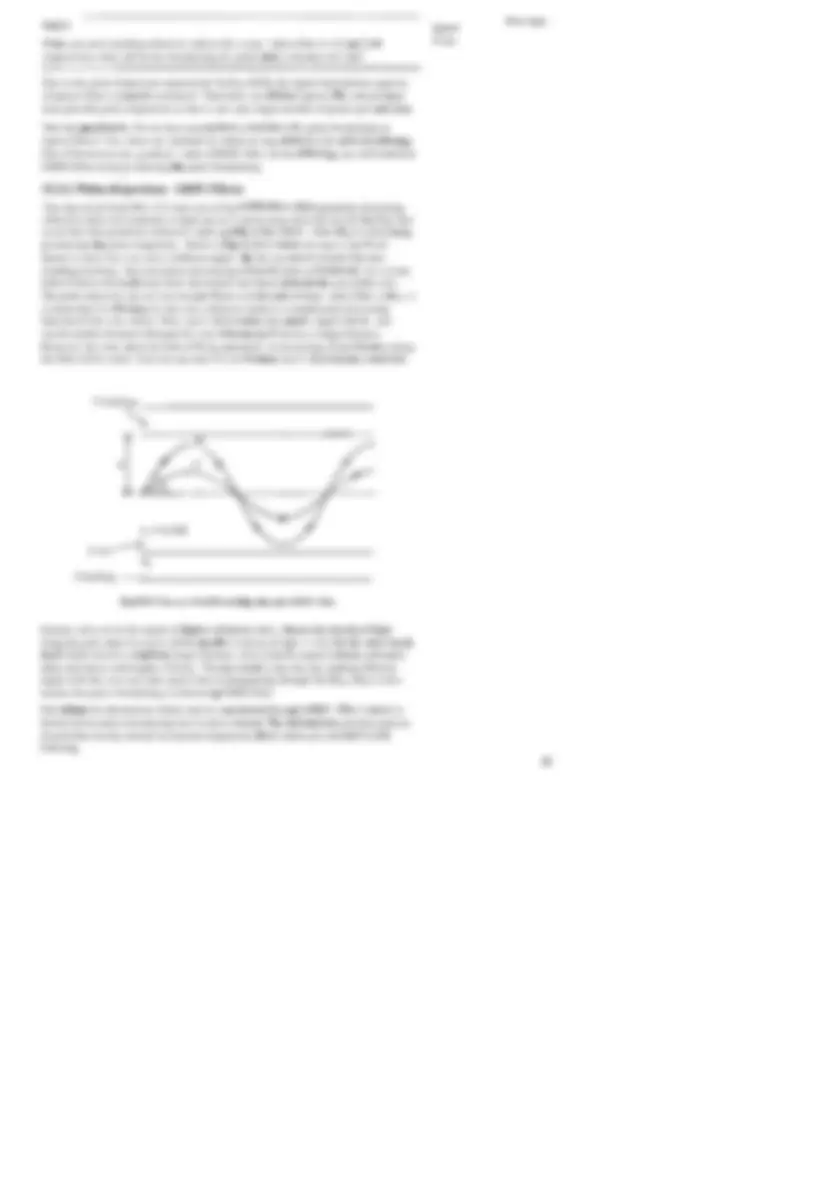
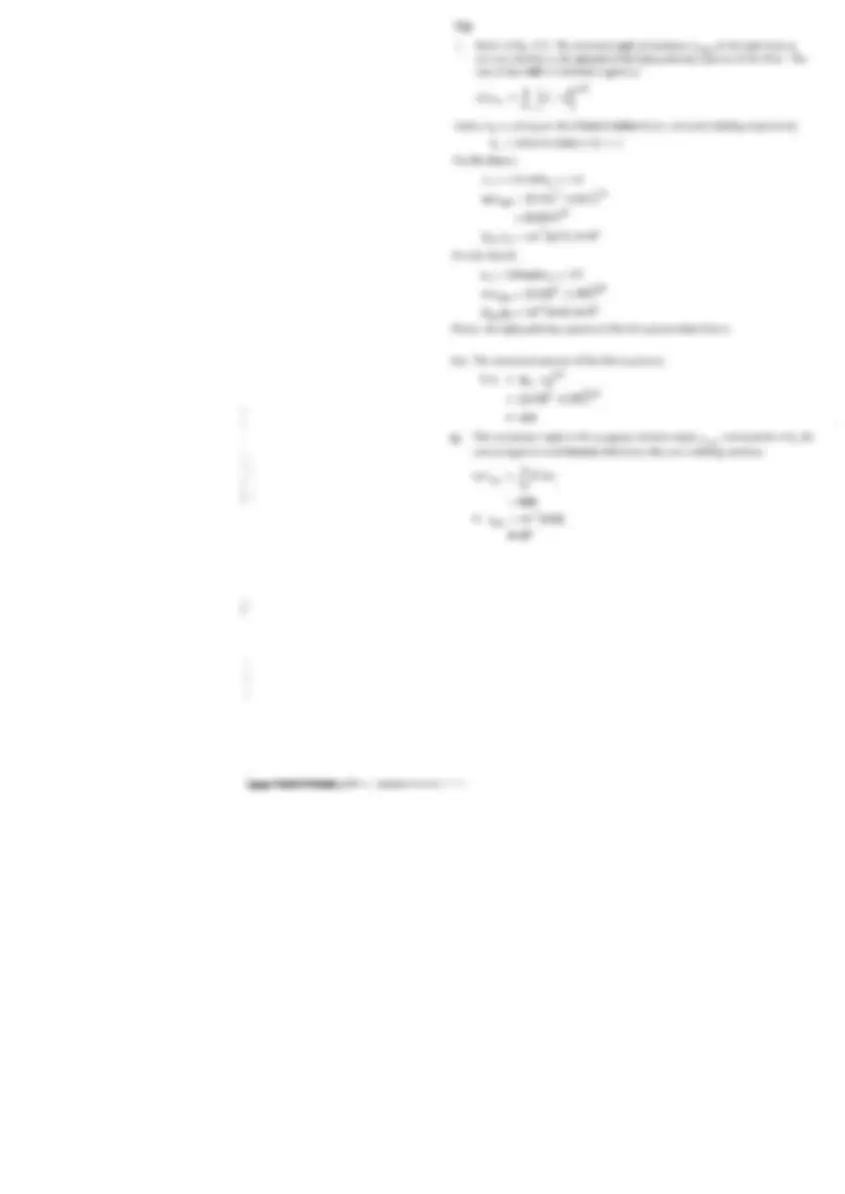
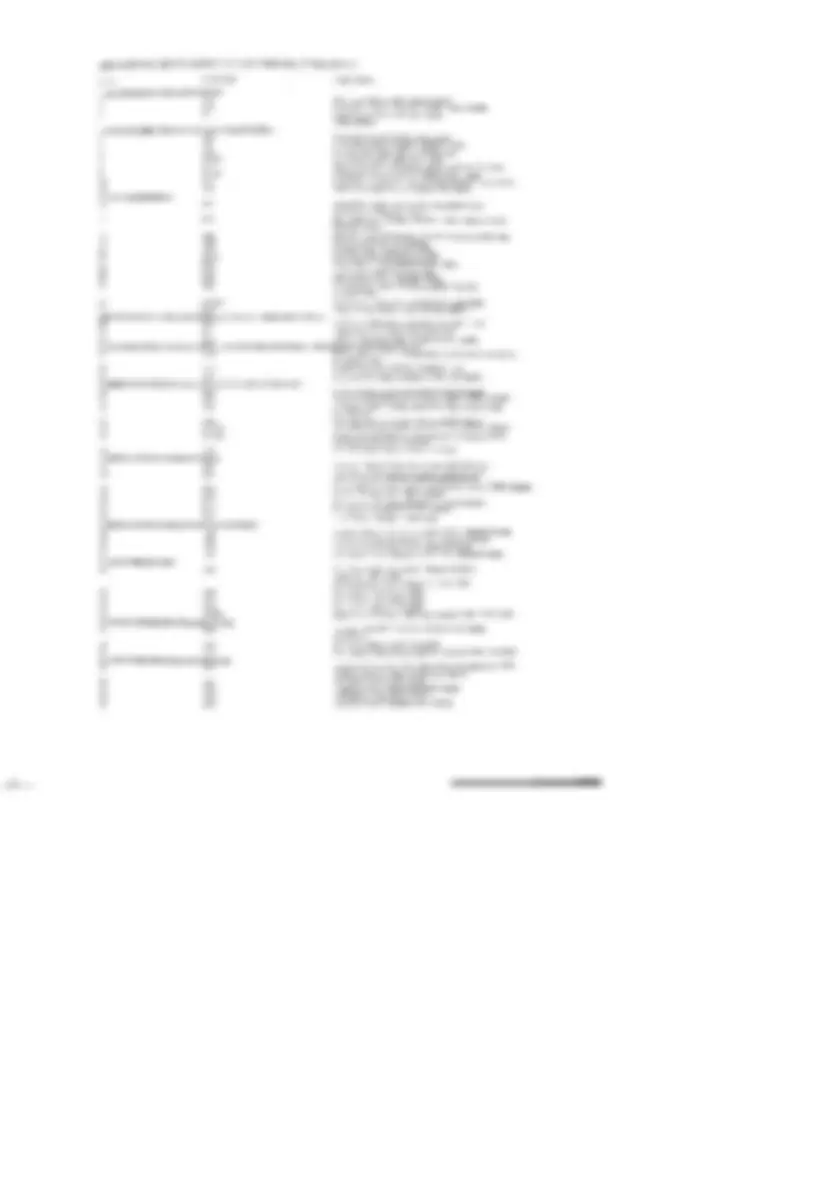


Study with the several resources on Docsity

Earn points by helping other students or get them with a premium plan


Prepare for your exams
Study with the several resources on Docsity

Earn points to download
Earn points by helping other students or get them with a premium plan
Community
Ask the community for help and clear up your study doubts
Discover the best universities in your country according to Docsity users
Free resources
Download our free guides on studying techniques, anxiety management strategies, and thesis advice from Docsity tutors
this pdf laser and its applications notes
Typology: Study notes
1 / 14

This page cannot be seen from the preview
Don't miss anything!









Lasers and lhelr Applleations (^) image forming device is needed and hence, as such, no image is formed on the hologram. What essentially is obtained is the interference pattern due to the light reflected from the object and the reference beam. Secondly, for obtaining hologram, coherent light is used whereas in case of normal photography, no such source of tight is needed. The requirement of coherent light is due to the fact that
used to render the reference and object beam on the photographic plate. (b) Hologram has several interesting properties. Some of them are given below: (i) The image obtained from the hologram has three-dimensional character unlike normal photographs which are two-dimensional. Due to the three-dimensional character of the image obtained in holography, you can observe different perspective of the object by changing the viewing position. Also, if a scene has beel recorded, you can locus at different depths. (ii) We d o not obtain negative in holography. Hologram itself, however, can be considered as negative in so far as obtaining the positive is concerned. Otherwise, there is no similarity between the typical negative of the ordinary photographs and the hologram. You may have noticed that when the negative of an ordinary photograph is seen through, we do get a feel of the object or the scene photographed. On the other hand, when we look at a hologram we observe a hodgepodge of speaks, blobs and whorls; it has no resemblance whatsoever with the original object.
2. Let amplitude of the signal (or the object wave) be _A_* and that of the reference wave be A2, then, as per the problem
When these two waves are out of phase, their resultant amplitude will be (10 - 1) = 9. On the other hand, when they are in phase, the resultant amplitude will be (10 + 1) = 11. Thus, the ratio of their intensities,
FIB OPTICS
Fibre Oplics
Structure 15.1 Introduction Objectives 15.2 Optical Fibre %es of Fibre Applications of Optical Fibre 15.3 Optical Communication through Fibres Pulse Dispersion : Step-Index Fibre Pulse Dispersion : GRIN Fibre Material Dispersion Power Loss 15.4 Summary 15.5 Terminal Questions 15.6 Solutions and Answers
15.1 INTRODUCTION
You might have seen advertisement dispalys (made of glass or plastic rods) and illuminated fountains. While looking at these, you might also have noticed that light seems to travel along curved path. In the above mentioned cases, most of the incoming light is contained within the boundaries of the medium (glass or plastic or water) due to the phenomenon of total internal reflection. And since the medium itself has a curved shape, the light travelling through it appcars to travel along a curved path. Optical fibre, which is made of transparent glass or plastic, also trailsmit light in a similar fashion. These fibres are thread like structure and a bundle of it can bc used to transmit light around corners and over long distances. Since optical fihrc can transmit light around corners, it is being used for obtaining images of inaccessible regions e.g. the interior parts of human body. The real potential of the optical fibrcs was, however, revealed only after the discovery of lasers. ' (^) You may recall from Unit 13 of this course that the discovcry of lasers - a source of
r coherent and monochromatic light - raised the hope of realising communication at optical frequencies. Since increase in frequency of the carrier wave enables it to carry more information, communication at optical frequencies ( - 10^15 Hz) has obvious
frequencies. But, early attempts at communication at optical frequencies faced a major problem. Whcn optical radiation travles through thc Earth's atmosphere, it is attcnuated by dust particles, fog, rain etc, Thus, a need for an optical waveguide was felt and the answer was the optical fibres. Optical fibres are an integral part of optical communication - transmission of speech, data, picture or other information - by light. In this unit, you will study about the optical fibres, especially in the context of optical communication. In Sec.15.2, you will learn the physical principles involved in transmission of light through fibres. Types of fibres used in optical coinmunication has also been explained. General considerations about the optical communication through fibres has been discussed in Sec. 15.3. In the same section, you will also learn about the requirements which must be met by optical fibres so that efficient optical communication may take place. The area of optical fibre is rclatively new and an exciting ficld of activity. A thorough understanding demands rathcr sophisticated mathematical background on the part oE the student. It has, therefore, bcen attempted here to kcep the mathematical aspects to a bare miilimum and the underlying physical principles have been highlighted.
~ransmissionof light, based on above principle, through an opticaI fibre of core refractive index nl and cladding refractive index n2 with ltl > n2 is sl~ownin Fig.15.3(a).
(b) FIg.15.3: (a) Light propagotion through a flbre by totnl l~iteninlrefleelion. @) Light pmpngntion through a bent fihrc.
When the ray of light is incident at angle 0(> 0,) at the core - cladding interface, it undergoes total internal rellection. Due to cylindrical synunetry of the fibre, the ray ' (^) undergoes total internal reflection at subsequcnt incidences at the core -cladding interface and hence gets trapped inside the fibre. Due to this "guiding"properly, optical fibres are also called "Optical Waveguides". Fibres in the bent form can also guide the light, as indicated in Fig.15.3(b), provided that, even at curved portion, the angle of incidence is greater than 0,. D o you know why cladding material is needed? The need for a cladding material of lower refractive indcx is due to two rcasons. Firstly, to achieve total internal reflection at the core - cladding interface. Secondly, when light undergoes total internal reflection, a part of it penetrates into the cladding material (region of lower refractive index). This may lead to leakage of light, and it may also couple with lr the light travelling in adjacent fibres. The use of sufficiently thick cladding material prevents this type of loss. You may note, from Eq. (15,2), that the critical angle for the incident ray depends on the refractive indices of the core and the cladding material. In Fig. 15.3(a), 0 is the angle at
, the angle, i, at which light is incident at the entrance aperture of the fibre. It is so
because the entrance aperture is an air (refractive indexrto - 1) - glass (refractive index nl) interface. Thus, according to Snell's law, (reler to Fig.15.3(i1))
no sin i = t i , sin q 5 (15.3)
Fibre Optics
Now, if this ray has to undergo total internal reflection at the core - cladding interface, from Eq.(15.2)
from A OAB, sin 9 = sin (90 - 6') = cos 6' = (1 - sin^2^ 9)1 / 2 2 112 = [ I - (n2ln1) I Hence, Eq. ( 15. 3 ), taking no = 1, may be written as,
.. SUI _I,,_* = 1 1 , sin p
1 / 2
capacity of the fibre. You should convince yourself that if the incidence angle is greater
the fibre aperture along the core formed by i = O to i = i,, will undergo total internal reflection in the fibre. The quantity (nlz - nZgln in Eq. (15.4) is called the numerical aperture of the fibre.
15. 2. 1 Types of Fibres As mentioned above, in its simplest form, an optical fibre consists of a glass core and a cladding (also of glass) of lower refractive index. This type of fibre in which there is a sudden change in the refractive index at the core - cladding interface is called Step-index fibre. The variation of the refractive index with the radius of such a fibre is shown in
I I (^) II I I II I *
Flg.15.4: Refraclive index proflle ofa step - index flbre.
In optical communication, signal is Fig, 15.4. transmitted through the fibre in the form of pulses. Further, when light travels through the optical fibres, there are different types of losses as well as a broadening of the pulse. These aspects of the optical fibres are of vital importance for optical comunication and have been discussed in the next section. In order to overcome some of the inherent deficiencies of the step - index libres, another type of fibre in use is called GRadient INdex Fibre (or GR.IN - fibre). In the GRIN
example of transmission of images using optical fibres is the flexible fibrescope. As shown in Fig. 15.6, some of the fibres conduct light into the cavity to be examined, while the others carry the image back to the observer. The image conducting fibres, upto 140000 of them, are by necessity very thin, often no more than 1 0 p m in diameter, and the entire fibre-bundle has diameter of the order of a few mm. Fibrescope are used extensively in medicine and engineering. They make it possible to inspect a cavity in the human body and to look inside the heart while it beats. Of increasing interest is the use of fibre guides for communication. Compared to electrical conductors, optical fibres are lighter in weight, less expensive, equally flexible, not subject to electrical interferences and more secure to interceptions. Fibres can now be made which has losses as low as 0.2d~km-'. This is a remarkable achievement considering that only a decade ago the best fibres had losses in excess of 1000 d ~ k m " and 20 d ~ k m - Iwas thought to be the limit.
15.3. OPTICAL COMMUNICATION THROUGH FIBRE
As mentioned earlier, optical communication refers to the transmission of speech, data, picture or other information by light. You may recall from Unit 13 that the replacement of radiowaves and microwaves by light waves is especially attractive because of the enhanced information carrying capacity of the latter. Optical frequencies are some five orders of magnitude higher than, say, microwave frequencies. Therefore, larger volume of information can be transmitted through fibre cable compared to that through copper coaxial cable (used for microwave communication) of similar size. Further, in contrast with metallic conduction techniques (e.g. through copper cables), communication by light offers the possibility of complete electrical isolation, immunity to electromagnetic interference and freedom from signal leakage. In a typical optical communication system, the information carrying signal originates in a transmitter, passes through an optical fibre link or an optical channel and enters a receiver which reconstruct the original information. In order to minimize the distortion, the signal is encoded into digital form before transmission. In this way, retrieval of the signal at some distance down the line depends only on the recognition of either the presence or the absence of a pulse representing a binary (0 or 1) digit, Minor distortion and noise may therefore be tolerated as long as pulses can be detected and regenerated, free from distortion. You may be wondering that with above advantages, why light was not used for communication purposes. It is not as if these advantages of using tight as carrier of information were not known. Rather, it was the unavailability of a suitable source of light which could be modulated. Light from lasers, being highly monochromatic, can effectively be modulated by the information carrying signals. The laser light, acting as the carrier wave, respond, either directly or indirectly, to the electrical signal say, from telephone. These signals can, therefore, modulate the carrier wave which then travel through tbe optical fibre (the optical waveguide). At the receiving end of the fibre, a photodet$tor receives and demodulate these optical signal into sound waves. For long distance optical transmission line, yet another component, called^ 'I repeater is used in optical communication system. Repeater essentially amplify and reshape the signal and retransmit it along the fibre. Optical cohmunication, as such, can be carried out thorugh open space. Then why do we need fibres to carry optical signals? The reason lies in substantial attenuation (or damping) of the signal while it travels in open space between the information source and information use. For example, communication between one sattelite to another is carried out through open space because the intervening region is essentailly vacuum. However, similar open space optical communication will not be feasible between a satallite and the earth or between two places on the earth because earth's atmosphere strongly influences the light transmission. Hence, the need for an optical waveguide (fibres) for terestrial optical communication.
Well, you have learnt in the previous section how light is transmitted through optical
from one point to another? No, the optical fibre must have some additional characteristics if at all it has to serve as an effective optical signal carrying medium. The optical fibre should be, as much as possible, free from pulse dispersion in order to carry large volume of information. Pulse dispersion arises because different light rays take different times t o travel a f ~ e dlength in the fibre. Secondly, as we know, even the light from lasers may have a spread in its wavelength. That is, even laser light is not completely monochromatic. And since the refractive index of fibre material is a function of wavelength, light of different wavelengths will travel with different velocities. This inherent property of material is yet another cause of pulse dispersion and is known as material dispersion. Further, the optical radiation will be attenuated by the material of the fibre due to scattering and other phenomenon. In the following you will learn how these problems can be tackled.
15.3.1 Pulse Dispersion in Fibres You may recall from Sec. 15.2 that rays of light incident at the core - cladding interface at an angle greater than the critical angle 6, undergoes total internal reflection and propagate through the fibre as shown in Fig. 15.7.
Fibre Oplics
Fig.15.7: Rays of light pnsslng lllro11g11n fibre
However, the ray, markedA in Fig. 15.7, which is incident on the core - cladding interface ; (^) at the largest angle will travel a longer optical pat11 as cornbared to other rays incident at
smaller angles. A s a result, different rays will take different times in traversing a given length of the fibre. This causes broadening of the information carrying pulses, as shown in Fig. 15.8. What effect the pulse broadening has on the signal transmission capacity of
The transmission capacity of the fibre is determined by the number of pulses transmitted per unit timc. For correct information retrieval, the pulses must remain resolvable i.e, they should not overlap each other.
Time-
Fig.15.8: Pulse dispersion: (a) At the input, the infornlalion cnrrylng pulses ere well resolved. (b) At the output, due to brondening, pulscs overlnp nnd are uhrcsolvablt.
SAQ (^2) Spend IFthe core and cladding refractive indices for a step - index fibre is 1.47 and 1.46^3 tnitl respectively, what will be the broadening of a pulse aftcr a distance of 5 km?
Due to the pulse dispersion represented by Eq. (15.5), the signal transmission capacity of optical fibres is severly restrained. Therefore, an efficient optical fibre should have least possible pulse dispersion so that it can carry larger number of pulses per unil time. Now the question'is: D o we have any mcthod to minimize the pulse broadening in optical fibres? Yes, there are methods by which we may minimizc the pulsc broarlcning. One of them is to use gradient - index (GRIN) fibre. In the fi)llowing, you will lcarn how GRIN - fibres help in reducing the pulse broadening. I 15.3.2 Pulse dispersion: GRIN Fibres You may recall form Sec. 15.2 that core of the GRIN-fibre orfcrs gradually decreasing refractive index environment to light rays as it moves away from the axis of the fibre. Lct us see how this parabolic refractive indcx profilc of the GRIN - fibre (Fig.lS.S(a)) helps in reducing the pulse dispersion. Refer to Fig.lS.10 in which two rays A and B are
both of them will bend away from the normal and hence towal-ds the axis of the core. The paths taken by rays arc not straight lines as in tlie casc of step - index fibre; rather, it is sinusoidal. It is bccause in the core, refractive index is a continuously dccrcasing function of the core radius. Now, rayA which makes the snialler angle with th:: axis travels smaller distance through tlic core whcreas rayB travcls a longer distance. However, the time taken by both of them, seperately, in traversing a fixed distancc along the fibre will bc same. Can you say why? It is so hccause rayA which travcls a shorther
Cladding
-
Core " Cladding -
Fig.15.10: Twn rnys Annd IS trnvellilig thro11gI1a GRIN- flhre.
distance, does so in the region of higlicr rerractivc indcx. Hencc Lhc vclocity or Iiglit along the path taken by rayA will hc snialler (vclocity of light = c h ). 0 1 1 thc ollicr hand, rayB which travels a rclatively larger distance, does so in thc region of lowcr rcrractive index and hence with higher velocity. The nct rcsult is that the rays making different angles with the core axis take equal time in propagating through the fihre. Due to this reason, the pulse broadening is reduced in GRIN - fibre.
The volume of information which may be transniiltccl tlirough GRIN - librc is morc or less free from pulse broadening due to above reason. Tllc infornialion carrying capacity of such fibre is only limited by material dispersion ahnut which you will lcarn in Lhc following.
1 5 3 3 Material Dispersion ~b~~~ we discussed about the pulse broadening in oplical l i b r ~ ~arising bcc;alsc of [Ile fact that light rays incident at different angles at tho core - cladding illterhcc take different times to traverse a faed length of fibre. We also discussed how to reduce tllis dispersion by using GRIN-fibre. Now, suppose that the light beam travelling through the fibre is free from the pulse broadening due to above mentioned reason. Does it mean that the beam is free from pulse broadening? No, tberc i s Y C ~ai~othersource of
variation of refractive index with wavelength, i.e. the vetocity of light in the medium is dependent upon its wavelength. You are aware that light even froin highly pure source (like laser which give highly monochromatic light) will have a s p r e a d is^ its^ wavelength, Therefore, different wavelengths, with in the range, will travel with different velocities and hence will arrive at the end of the fibre at different times and. cause broadenin. (^) g of the pulse. You may note that the material broadening is an intrinsic physical property of the fibre material. Although glass is transparent to electromagnetic radiation in t h e visible range, it does absorb a part of it due to several processes. As a result, the i n p r ~ tpowcr of the light beam will suffer a loss while traversing the length of the fibre. In the following, we briefly discuss some of these processes causing power loss in fibres.
15.3.4 Power Loss When eleclromagnetic radiation interacts with matter, it may lose el~ergyvia different mechanisms. In case of optical fibre material, silica, major loss in energy 01.powcr is ,
the fibre material should be of high purity. Secondly, the photons may also lnsc energy by exciting the atoms of oxygen and silicon (the building blocks of silica, Si02). Thirdly,
this, the propagating light beam may gct scattered and its direclioh of propagating may
and synthesis technique of the fibres. The power loss we are talking about is expressed ill ternls of be1 or dccibcl which are cornparablc units. One be1 means that power in one chan~iclol. at one liille is 10 timcs that in another channel, or at another time. 2 be1 means 100x, 3 bcl ll~cans1000~a11d so on. For practical use, the unit be1 is too large. Hcnce the decibcl, dB, is uscd. 1 bcl = 10 dB. A decibel (dB) is equal to 10loglo(pz/P,) where pl ant1 p2 a r c input 21nd oulput *powerelevels. Thus, if the power level of an optical signal reduces by half, the power loss in decibels will be 1010glo(1/2)= -3dB. In optical fibre comm ~~nication,the power loss is expressed as dBkm-I. In long distance optical communication through Ohrcs, tile permissible loss is 20dBkm-l. With modern techniques of synthesis, optical fibres with
15.4 SUMMARY
refractive index. Since the refractive index of the cladding material is lowcr than that of the ewe, much of the light launched into o n e c ~ l dwill cmcrge frolll the other end due to a large number of total'internal reflections. In the step - index fibre, the refractive index chal~gessuddenly at the core- - - cladding interface. On the other hand, in the gradient - index (GRIN-) tibres, the refractive index decreases continuously Gom tlie core a& as a functioii of radius.
TQs
air - core interfacc is the measure of the light gathering capacity of the fibre. The sine of this angle oC incidcnce is givcn as
sin i,,, = -^1 1 1 ; - I,;] 1/ I1o where, ,to, nl and w2 arc the rcfractivc indiccs of air, core and cladding respectively. 11, = refractive indcx of air = 1. For the iibre A, n l = 1.52 and1t2 = 1. sin , , i = l(1.52)' - (1.41)']~" = [0.3223]'/~ (i,,), = sidl [0.57] P 35' For the fibre B,
sin , ,i = [(1.5312 - (1,39)~]*/~ = sin-' [0.64) 40' Hence, the light gathering capacity or fibre B is greater than fibre A.
2.a) The numerical aperture 01 the fibre is given as, N.A. = [ 11 - 1 1 ~ 1^ 1/ = [ ( l. ~ 3 ) ~- (1.39)'jlR
critical angle for total internal reflection at the core - cladding interfacc.
sin i,,, = -^1 [N.A.! llo = 0.
..
V.K, t.'~dlc&:u.Ncllnrc-S2.1IWI1,An11hr;r hsllcsh I(1IN ('arllcgo. I b ~ l l ~ ~ ~ p u l .Vipy;1wadr1-5200(ll,Anllhru Pradcsh AIIIOI.,L'< I>ccsCIIIII..Ilyd~1al~i~il.50(~LIl, h ~ ~ r l l l r uE'rnrlcrh (~i~lwi~huliIlivcrs~ty.Ciuwnhnli-7Xl01.1, Assnn~ l l l q l l ~ ~ r l ~MIIIIIIVI~YIIII~. Il0llpnigi1~1n.78328~1,(;uwnl~nll ~lclllllllilcGirl5 <'llIIcge. ;~l;r.Pellis~lln I?O. Darpct;~I)rslrlc~-7813?5.Assnm i)vlri3d Illby (:~~llcgc.Ci~ilnghalI'.O. (ielogbn1-7X5621,Arsnln I. i ~ k l r l ~ l ~ l ~ t ~ r('ililh I:IIIIc~P. K t l c l t ~ ~ i ~ nP.O. N o r ~ hLnkli111ip11r-7X703I, Assan Sikkllr~linvl. Cqollegc. '[brlony, Giinglrrk-737102.Sikklmllwil~1illi-7HIIDll, Assnm l i t ~ v tScicncc Ciillc~e.J~I~III~I-~XS~IO,AWAIII l111la11('llcgc.I'ctl
13 05:I~l^ 1I.R.S. MIII.II'III~IIII,^ Hih~lr lllliversityUtI~ur)^ I.ibrary.^ M U Z ~ ~ ~ ~ I ~ ~ I ~ I ~ - W ~ ~ O I I I .nllrnr^ (^1 .s^ college, 14 OCOS Mlirw;lri ('o1legc.U". l l l ~ n p i i l ~ ~ u rUniversity). Rl1n~olpur-Al2007.~ i ~ l ~ ~ ~ 15 115OH I'urcIlll Ccrtlcgv, l'11r11ca-HSr1301,1)lhnr I b 05l10 ~tlilclltll;~('~allcgc.('lrl1:1prn-X4l3Ol, nlllflr 17 05 I SIt Rvllbil Villyll~ll'~'l11,l. : ~ k l ~ i s ~ ~ r i ~ i - A I 131 I, Ulllnr 18 0 5 2^ I^ Sllllltl^ (:'ollcgc.^ I!(>.^ Sllnl~i.I(:X^111.^ Dlinnbnd,^ UIIlnr^. 1'1 20 0523 052.1 I'Ll~hnrhl.^ ( ' ~ ~ l l e l : ~ .NIIII~IIIII~ Kili~l:l~i~t.( ' C ~ I I S ~ : ~ ~ .P~IIIII.x(x)(~).I,I)i~rI~l~nngil, I3lllllr~ I I ~ ~ ~ ~ 2 1 05?5 h f i ~ l i i l i ~Ivllc:;~,('II;II~I~I$:I,1'0, CII~I~IIII~~I.#~~~[II,Disl. wcsl 1111~~~1~l~111111,I!II1111. 22 (19.?H(I>) 51, ~.'~IIIIII~III~ l'i~ll[:c,l1,<1.Collcgc More, llx~.:1ribngl1-8253Ol 21 IlS?.~> AI~II:~.LII N i l r d ~ l l lCollc&r, nitri~ll:I t ~ i ~ d .l'alna-HDIKII
4. I)lII.Al llE(;ION IllISot1l1111111l WPSIHC#IIIII, (;III~#~IIIII, l ' k ~ ~ d l 1 ~ 1 l l dlllld h!l~llllll'll) 2:1 07117 MI'HC. JIIIIII,~ Millill I~~IIIII~I.J~IIIIIII N i ~ # i l ~New D c l l ~ i - lI (^25 1111 1) Ii ~ i r i ~ ~l't~Ile[y,Sin Vc~flI<I,;III, New I)cIIII-I I~[MI> 26 11'115 Acl1111yi1N;lrrt~~lii~I)cv ('ollcge, Knllnji. Ncw I)ulhi.I I(X)I 5, I)ICLIII 1t11010N (21 (Nert11 IIIII~linsl HCKIIIII IIICIII~IIII[h i e ~ r ~ l l ,h l ~ ~ ~ l l ~ i ~ l l : n r 311111 (~11114111b11111)IslrIcI~of (llll~rI'rl~dcsI~) 27 IU?H I l l a + l i i r i! r l ~ ~ ~ r y ; ~l ' u t l r ~ c 111 Apl>licd Scicllce. Vccr Suvnrknr C~mn~plrx,Pusn Nuw 1)cllrl.l IlXII 28 o7.V~ K(II~IIIII^ (:IIIIC~C,^ I:JI\I^ C ~ ~ I ~ C INII~II~N^ ~^ WI)CIIII.^ I^ I(HNIX 29 .!'/.I 1 I,a111i11lN11t lll.li.) <',tIlegc, S11hihitl~i11l.2lilI~lS.l l l l n r l'rndcsh
36 ?~1111 lIlal.^ Arts^ I',~llcl:c.^ I~;III~.I~I,111~1^11111 111 '1:).^ 11JO?IO